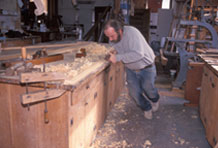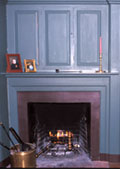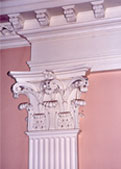Occupational Traditions – Historic Restoration
In New Hampshire people value and preserve history in all forms, especially buildings.

David Adams working in the
Adams & Roy Headquarters, an
an 1885 shop in Portsmouth they
call "The Last Chance Garage."
He is using a traditional planing tool
to shape a piece of molding
for a restoration.
Many of New Hampshire's houses, churches, town halls, and other public buildings were built in the 1700s. The style of architecture is began as Georgian and evolved into Federal. Some early buildings were constructed of masonry-granite or brick. Most were constructed of wood. Almost all contain distinctive exterior and interior elements such as moldings and paneling. All of these were originally made using hand tools.
In the mid-1800s, advances in technology such gave builders more choices. As a result, more elaborate exterior and interior detailing became available. The highly ornamental style became known as Victorian.
Many of New Hampshire's older structures have stood the test of time. They do, however, require a great deal of maintenance. And this requires very particular skills and resources. As David Adams says, "There is no book that shows you how people built things, there are only houses that show you how people built things – and only tools to teach you how it was done."
Up until the mid 1900s, most old New Hampshire buildings and homes were repaired by their owners or a local handyman. In the last 50 years, however, more people have been turning to specialized craftsmen trained in methods of historic restoration. Specialized businesses have emerged to make clapboards, shutters, paneling, cabinetry, historic-style bricks, doors, window sashes, and hardware such as hinges and door latches.
Financial support for the restoration of historic buildings has been spurred on by various pieces of national legislation. The Antiquities Act of 1906, which set aside federal lands containing significant cultural or scientific resources, was the first important step in raising public consciousness about the importance of preserving our historical resources.
In 1966 the National Historic Preservation Act established the National Register of Historic Places to record districts, buildings, and objects. Most states have put in place State Historic Registers as well. This has sparked a movement in old house restoration and preservation that has become particularly strong in New Hampshire. The State of New Hampshire's Division of Historical Resources works closely with organizations like the New Hampshire Preservation Alliance and other projects throughout the state. Architectural historian Jim Garvin and others on staff are respected throughout New England for their knowledge and personal commitment.

Paneling and fireplace
in the dining room of
the "Oracle House"
in Portsmouth, NH.
The house was
originally built
in the early
1700s and moved
to its present
location in 1937.

Many of the
mouldings and
elaborate cornice
work of the
Unitarian Universalist
Church in Portsmouth
are plaster – some
pre-cast and some
cast in place.
The church was
built in 1824.
Photo credit: Lynn Martin Graton
New Hampshire State Council on the Arts
19 Pillsbury Street - 1st Floor, Concord, NH 03301


